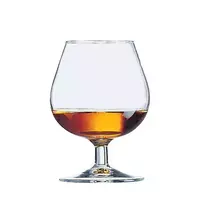Cognac

Many lovers of elite alcohol prefer a strong drink, the birthplace of which is France - cognac. It is produced from certain types and varieties of grapes, and according to special technologies. This strong alcoholic drink owes its name to the French city of Cognac.
Today it is already quite difficult to talk about the traditions of drinking this drink, since time is constantly making its own adjustments. But still, until recently, cognac was usually served exclusively in "snifters" - traditional spherical glasses of tapered up, specially created for this expensive elite drink. The glass needed to be held in the palm of your hand, warming the cognac with its warmth, rotating the drink along the walls of the bowl and enjoying its aromas, occasionally immersing your nose in a vessel.
But time does not stand still, and recently a more traditional glass is beginning to be considered a "tulip" - a glass, a distinctive feature of which can be called a bowl in the form of a half-open flower bud. How to stop your choice is to decide for the consumer himself. By the way, it is not customary to heat or cool cognac - the room temperature is considered the optimal supply temperature.
Interestingly, the French themselves have fixed the traditional combination of cognac, like a digestif, with certain products, namely, they believe that this drink is best combined with three "C" - coffee (French cafe), chocolate (French chocolat) and cigar (French cigare). In addition, cognac is widely used for culinary purposes, where it is often added to various dishes and prepared with it low-alcohol drinks. The calorie content of cognac is 239 kcal per 100 grams.
Composition of cognac
The composition of cognac is undoubtedly diverse, but still the main components of this drink are alcohols, organic acids, their ethyl esters, as well as vanillin. Typically, the content of volatile components in cognac does not change much as the retention time increases.
The greatest positive contribution belongs to ethyl esters of fatty acids, which are part of cognac. Their high content allows you to maintain all the taste of this strong drink even in case of dilution.
Types of cognac
The wonderful aroma and amber color of cognac has been attracting true connoisseurs and connoisseurs of expensive alcohol for more than a century. However, not everyone knows what the difference between types of cognac is and what the coding means on bottle labels.
In accordance with the classification, which was developed and adopted by representatives of the National Interprofessional Bureau of Cognacs, cognac species are distinguished depending on their aging. Therefore, when choosing a high-quality French drink, pay attention to the Latin letters that must be present on the label:
V. S. - cognac with exposure in a barrel of at least two and a half years;
V. O. is a very old cognac;
V. S. O. P. - light very high-quality cognac with aging in a barrel for at least four years;
V. V. S. O. P. - even better old light cognac, aged at least five years;
X. O. - extra-old cognac, which has an exposure of at least six years.
Cognacs that have been aged for more than 6 years are not classified, since it is believed that it is not possible to control blending processes at this stage. However, the special pride of some cognac houses in France is elite cognacs, which differ in a rather mature age - 25-65 years.
cognac 239 kCal
The energy value of cognac (Ratio of proteins, fats, carbohydrates - ju):
Proteins: 0 g (~ 0 kCal)
Fats: 0 g (~ 0 kCal)
Carbohydrates: 1.5 g (~ 6 kCal)
Energy ratio (bj | y): 0% | 0% | 3%
 Español
Español Français
Français Português
Português Русский
Русский 简体中文
简体中文 繁體中文
繁體中文 日本語
日本語 한국어
한국어 العربية
العربية Türkçe
Türkçe Қазақ
Қазақ Deutsch
Deutsch Italiano
Italiano Українська
Українська
